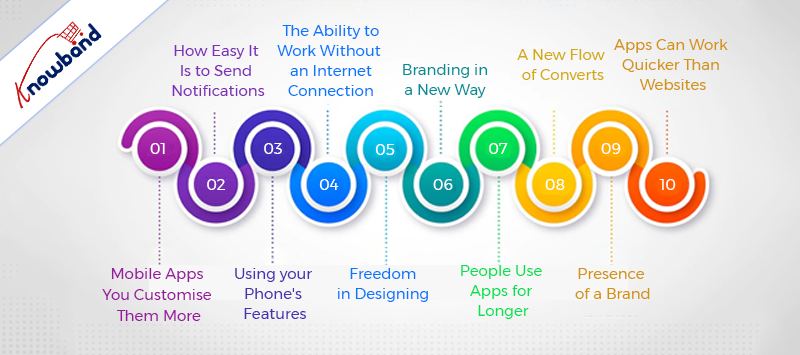So the mobile era is here. There are more mobile users than desktop users right now. Because of this, businesses have realized that they need to use mobile channels to attract customers. But that won’t do. To get the most out of this channel, they also need to improve the user experience on their mobile apps and websites and beat their conversion rates.
Some businesses use both mobile websites and mobile apps, but other businesses might choose just one. Choosing between mobile apps and websites depends on how much they cost, how easy they are to use, what features they need, and who they are for.
Studies show, though, that people prefer mobile apps to mobile websites. This is a good reason to reach out to potential and current customers by making mobile apps.
Mobile Apps are Better than Mobile Websites

#1: Mobile Apps Let you Customise them More
The goal of personalization is to give users more relevant information based on their interests, location, how they use the service, and more.
With mobile apps, it’s easy to make each user’s experience unique. With an A/B testing tool for mobile apps, you can also try out different ways for your customers to interact with your app.
At the start of using a mobile app, users can set their preferences, which can then be used to serve them customized content. Apps can also keep track of how customers use them and use that information to give users personalized suggestions and news. Also, they can find out where users are in real-time so they can show content that is relevant to their location.
The personalization of an app is better than the personalization of a mobile website. Personalization does more than just make the user experience better, though. It can also help apps get more people to use them. When users are treated to personalized content, they are more likely to convert because it has a human touch and doesn’t seem like it was written by a robot.
#2: How Easy it is to Send Notifications

In business, email has been the most popular way to talk to people for the last 20 years. Businesses have used email a lot to reach out to their users, and some have used it almost too much. Because of this, email isn’t as useful as it used to be; the number of people who open it and click on it keeps going down.
So, there’s nothing to worry about.
There are two kinds of these alerts: push and in-app. Both are interesting ways to get in touch with app users in a much less annoying way.
One of the main reasons why many businesses want a mobile app in the first place is so that they can send users instant notifications that don’t bother them.
In-app notifications are alerts that users can only see when they open an app. On the other hand, push notifications are alerts that users can get no matter what they’re doing on their mobile devices.
# 3: Using your Phone’s Features
Mobile apps can use the camera, contact list, GPS, phone calls, accelerometer, compass, and other features of a mobile device.

When used in an app, these device features can make the user’s experience more interactive and fun. Also, these features can help users do less work than they would have to otherwise. For example, users filling out a form on a banking app might need to upload a picture of themselves to finish the process. The app lets users take and send pictures using the camera on their phones. The features that work together make it much faster to do a certain task in an app and increase conversions.
Some mobile features, like the camera, GPS, etc., can also be used on mobile websites.
#4: The Ability to Work Without an Internet Connection
This is probably the most important difference between a mobile website and an app. Apps, like websites, might need to be connected to the internet to do most things. However, an app can still offer basic content and functionality even when it’s not connected to the internet.
Even without an internet connection, these features can be used. Even though mobile websites can load web pages without an internet connection by using caching, they can only do so much.
#5 Freedom in Designing

Even though web design has come a long way in recent years, mobile websites still need browsers to do even the most basic things. Web browser features like the “back” button, “refresh” button, and “address bar” are needed for mobile websites to work.
Mobile apps, on the other hand, don’t have to follow any of these rules. The functions of a mobile app are built around advanced gestures like “tap,” “swipe,” “drag,” “pinch,” “hold,” and more. These gestures can be used by apps to add new features that can help users do a task better. For example, a swipe can be used in an app to move to the next or previous step.
#6: Branding in a New Way
Since a mobile app is different from a company’s website, it can give users a different feel for the brand. It means that the company can try out different ways to brand the app, which might be different from how it usually brands its website (or the company altogether).
To take it a step further, companies can build mobile apps that help them change to a new brand style. A mobile app can also let users change the way it looks so that it fits their needs. This can help even more with making the app fit your needs.
#7: People use Apps for Longer
Max of mobile users’ time is spent on mobile apps, while only approx 10% of their time is spent on mobile websites. Users spend most of their time on games and social media apps, which is something to think about.

#8: A New Flow of Converts
If you want to boost conversions, mobile apps are a simple way to move users further down the conversion funnel. You can get both top-of-the-funnel (ToFu) and bottom-of-the-funnel (BoFu) users with a mobile app.
Since mobile apps are much more targeted (because of their content and how they work), you can use them to reach specific users in the funnel. Mobile websites, on the other hand, reach a wide range of people.
#9 Presence of a brand
A large amount of time is spent on mobile devices by users. It’s safe to say that a lot of people use the apps they’ve downloaded almost every day. This regular meeting is a chance for the apps to get their names out there.
Even when people aren’t using a mobile app, the app’s brand is brought to their attention. The app’s icon is a little advertisement for the brand.
When a user has an app on their phone, tablet, or computer, they subconsciously think more about that brand.
#10 Apps Can Work Quicker Than Websites
A mobile app that is well-made can do things much faster than a mobile website. Websites usually store their data on web servers, while apps usually store their data on the mobile device itself. Because of this, data retrieval in mobile apps is quick. Apps can save users even more time by remembering their preferences and doing things for them before they ask.
There is also a technical reason why mobile apps can work faster. Most of the functions of mobile websites are done with javascript code, but the framework that mobile apps use can run almost five times faster than javascript code. While all of this is happening in the background, mobile app users can finish tasks faster on the front end, which again adds to a great user experience.
What Should You Choose Between a Mobile App and a Mobile Site?
Creating a mobile website and a mobile app for your business can be expensive. Depending on your budget and business goals, you may have to choose just one of the two. Mobile apps can help you increase sales and keep customers for longer even though both channels have advantages and disadvantages. Mobile apps enable you to, among other things, further customize and improve the performance of your device.
But once you’ve made a cool mobile app, how do you make sure it lives up to all its promises and helps your business grow in the way you want it to, instead of just becoming another channel you have to manage and keep up with?
With mobile app A/B testing, you can slowly improve the user experience inside the app by trying out different features, app flows, and other changes to the user interface (UI) to increase engagement, conversion, and retention. So, having a mobile app that is up and running is the first step toward connecting with a whole new group of people. Keeping it optimized will help you make real improvements in your key business metrics. If you’re not sure, ask for a free demo from one of the experts to learn about the functionality and installation of Knowband’s Mobile App Creator.



